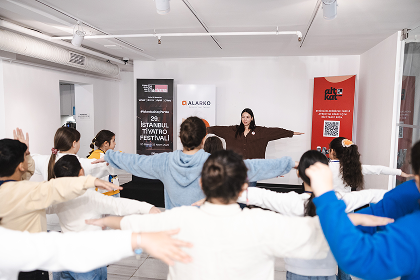Alsim Alarko Renovates Astana's Treatment Infrastructure
The entire potable and waste water treatment facilities and related distribution and collecting piping network of the city of Astana, where the Expo 2017 will be held, are being built by Alsim Alarko (Alarko Contracting Group). The project of the Governorship of Astana, which has a budget of around 1 billion dollars as investment cost, is based on the principle of effective management of raw water and the reserves that supply water to the capital city. Deputy Chief Executive Officer of Alarko Holding A.Ş., Alper Kaptanoğlu pointed out that their first aim within the framework of the project was to improve the raw water reservoirs and connect them to the city. Kaptanoğlu stated that treatment of raw water, renovation of the entire urban network and modernization of the existing waste water treatment facility and improvement of capacity followed this stage.
Alper Kaptanoğlu emphasized that they solved a major lasting problem of the city thanks to their project of providing the hygiene conditions necessary for both effectively managing the water sources available to Astana and making water suitable for use. Commenting that the water supply problem of Astana, which increased its growth momentum thanks to the EXPO 2017, is a critical issue, Kaptanoğlu said: "In addition, our project focused on meeting the growing need for a waste water treatment facility, rehabilitating the waste water collection areas and restoring the ecological balance. Thus, we have timely fulfilled all our undertakings within the scope of our efforts so far."
"Thanks to Horizontal Drilling, We Have Not Caused Any Harm to Social Life"
Alper Kaptanoğlu stated that the pipe installation work to be performed in Astana was planned to be done by way of open excavation, but they saw that performing excavation & back-filling work would extend the term of the project because of the roads on the active traffic line and the population density in residential areas. Pointing out that excavation & back-filling method was not preferred in the project since it also poses the risk of environmental pollution and damage to third parties, Kaptanoğlu noted that they used the horizontal drilling method for a project of this size for the first time in Kazakhstan.
Alper Kaptanoğlu emphasized that they achieved progress in the project without causing any impact on the traffic flow and public social life thanks to the directional horizontal drilling method they introduced to Astana, and added: "Thanks to this method, we installed a pipeline of 120 kilometers in one take. I think we have achieved a first in the world by using horizontal drilling method for such a large area in one take."
"We Cleared 5.6 Million Cubic Meters of Sludge From The Lake"
Alper Kaptanoğlu stated that the waste water treatment facility in Astana had become operational in 1972, but since 2000, waste water had been discharged to the Taldykol Lake with almost no treatment being involved, and that ecological balance was totally ruined due to this process. Highlighting that they restored the ecological balance in Astana thanks to their project, Kaptanoğlu said: "We cleaned the Taldykol Lake, whose bottom was fully covered in sludge, using five dredges within the scope of our contracted works, and brought back its good old days."
Noting that they constructed a water intake structure at a distance of 200 meters inland at the coast of the lake, used as the main water supply reservoir of Astana, Kaptanoğlu commented: "An access platform filling was built in the lake, an impermeable wall was constructed with intersecting posts, then a level of 23 meters from the surface was reached by way of excavation, and construction activities began for the pumping station which will pump water to the city." Informing that dredging activities were performed during the project using 11 vessels and auxiliary equipment, Kaptanoğlu stated that the fleet had a capacity of 2.400 cubic meters / hour and its largest vessel was designed by company engineers and manufactured at the shipyard built by the lake.
Kaptanoğlu stated that, through floating pipes, the sludge cleared from the bottom of the lake was dewatered in 960 geotextile tubes, 60x14 m. each, located in the drainage area, and added: "With 5.6 million cubic meters of mud cleared and 960 geotextile tubes used, our project is the first project in the world which involved the largest area among its counterparts. Thanks to these efforts, the lake was cleaned entirely, wetlands were dried, and the lake was converted into a recreation area. The still-existing reed was freed from mosquitoes and bad odor, letting natural life in the area revive and giving a new appearance to the city of Astana." Kaptanoğlu added that the water treated at the new treatment facility, which now meets the UNESCO standards for water treatment, was recycled and used for feeding the Esil River surrounded by residential areas.
Astana's Infrastructure in Figures
210.000 cubic meters: Daily capacity of the water intake facility
105.000 cubic meters: Daily capacity of the drinking water facility
136.000 cubic meters: Capacity of the sewage treatment facility
93.500: Number of the water meters installed within the scope of the project
4,3 million cubic meters: Amount of soil used for the filling procedure performed in the basin of the lake


Field Analysis on Sustainable Agriculture by Alarko Holding and SKD Türkiye

Alarko Holding Aims to Foster a New Generation Growing Up with Art Through the “First Step into Art” Project, Implemented in Collaboration with İstanbul Foundation for Culture and Arts (İKSV)








